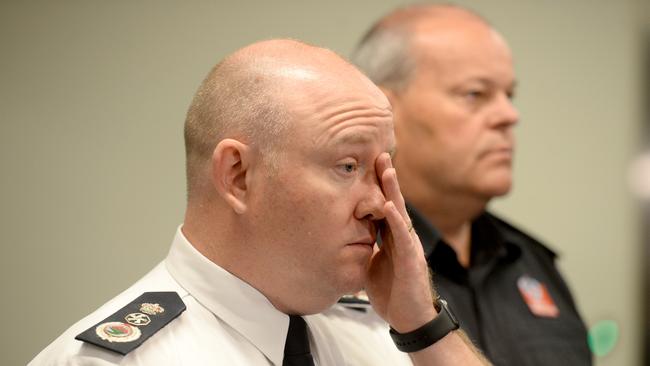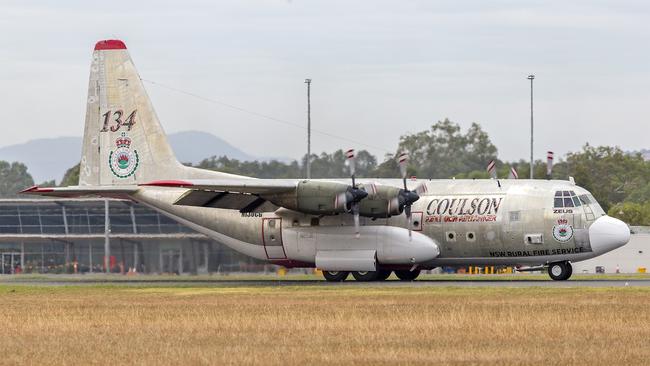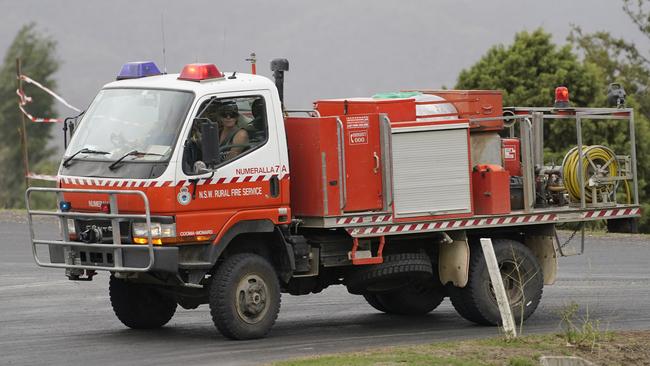American tragedy: Hero US aircrew die fighting fires
RFS Commissioner Shane Fitzsimmons choked back tears as he spoke about the sacrifice North American firefighters had made to protect Australian homes and lives during this unprecedented bushfire season. His comments follow yesterday’s tanker crash which killed three US citizens volunteering in NSW.
NSW
Don't miss out on the headlines from NSW. Followed categories will be added to My News.
RFS Commissioner Shane Fitzsimmons choked back tears as he spoke about the sacrifice North American firefighters had made to protect Australian homes and lives during this unprecedented bushfire season.
This morning at the Novotel at Wolli Creek, alongside NSW Emergency Services Minister David Elliot, Mr Fitzsimmons thanked the group of 32 American and Canadian men and women for their service.

The gathering follows Thursday’s fatal plan crash which claimed the lives of three US aerial firefighters.
“You put your hand up knowing that you would come here during Christmas and New Year, a time which is recognised as the most precious time to spend with family and loved ones,” he said.
“You put up your hand to come over here and commit to us during some of the most difficult and unprecedented fire conditions speaks volumes of your commitment and dedication.”

The group of men and women have been in Australia for around 30 days and primarily worked with the incident management crews.
They have all volunteered to come here and fight the fire without pay.
CRASH SITE
It was with little room for error that the three heroic American aerial firefighters had been flying up to eight water-bombing missions a day before their C-130 Hercules crashed in a fatal fireball on Thursday.
The highly skilled crew had battled hot turbulent winds as they manoeuvred the massive air tanker full of 15,000 litres of water and fire retardant just a few hundred feet off the ground, protecting lives and homes.
Remembered among the devastated tight-knit firefighting family as a “remarkable, well-respected crew”, the brave trio had dumped over two million litres of water and fire retardant on multiple blazes since arriving on November 5.
They had flown more than 130 missions since December 1.
US Vice President Mike Pence tweeted his condolences to the families of the three men who died as aerial footage of the crash site emerged.
Karen & I send our prayers & deep condolences to the families of the 3 brave American firefighters who died in AUS yesterday while on their way to battle the terrible bushfires. Our Nation will always honor the memory of those lost in the line of duty working to help others.
— Mike Pence (@Mike_Pence) January 23, 2020
FIRING LINE
The tragedy came as temperatures surged back into the 40s, pushing seven bushfires to the emergency warning level across NSW and the ACT and plunging Canberra Airport into limited operation due to low visibility from smoke and flames.

A fire at Box Hill in Sydney’s northwest was downgraded to “watch and act” after 1pm while blazes flared at Clyde Mountain and Badja Forest on the south coast, Adaminaby in the Snowy Mountains and Big Jack Mountain and Glen Allen in the Bega Valley area.
The air tanker, called Zeus, was fighting two emergency-level fires in the Snowy Monaro region after taking off from RAAF Richmond at 12.05pm when it lost contact with ground crews around 1.45pm, 16 minutes before it was due to land.

The wreckage of the aircraft was found by defence force and RFS helicopters close to Peak View, northeast of Cooma.
The impact resulted in a massive fireball, with emergency services only finding the tail of the aircraft still intact.
CODE RED
The local fire brigade called in a code red when they saw the crash.
“Fire comms, message red. Peak View, message red. Crashed — over,” they said over the radio.
“Yeah fire comms. It’s just a ball of flames — over.”
Sue Millner was at the RFS station when she heard a volunteer from the Jerangle/Peak View Brigade call over the radio. “He said he saw the crash and sound panicked,” she said. “Then he asked to be called on his mobile so I knew it must have been something bad.”

The crew was with the privately owned North American company, Coulson Aviation, which has been working with the RFS for the last five years.
“They’re absolute professionals,” Rural Fire Service Commissioner Shane Fitzsimmons said yesterday.
“The firefighting fraternity is a tight-knit family, a fairly small family and the crew on board were well known, not just to their colleagues here in Australia, but we’re reminded that a number of our US colleagues who are embedded with the incident management teams actually had personal relationships with them.
“Our hearts are with all those that are suffering what is the loss of three remarkable, well-respected crew that have invested so many decades of their life into firefighting and fire management and are professionals in the aviation sector and the aviation firefighting sector.”
A response team from Coulson Aviation is already on its way to Australia.
RISKY MISSIONS
The US military-designed C130 is a workhorse of the skies but aviation expert Tim Collins from Upstream Aviation said flying just a few hundred feet above the ground, in hot conditions, while targeting a specific part of the part of fire, made waterbombing operations an “uncomfortably difficult place to be” for the crew.
“It requires a huge amount of skill and they are very trained and very experienced because there’s not much room for error,” Mr Collins said.

As the Australian Transport Safety Board announced an investigation into the tragedy, Mr Collins said there were three likely scenarios that may have led to the crash, including that it was engaged in a manoeuvre that overstressed the plane and made it break up in flight or that the crew lost control while flying close to the ground in turbulent weather.
“The third, less likely, scenario is that they got really close to the fires into some smoke and became disoriented and crashed,” he said.
Mr Collins said the Hercules was highly versatile and frequently used to respond to natural disasters across the world. It is the first firefighting crash involving the aircraft since 2006.
In a mark of respect for the crew, flags in NSW will fly at half mast today and all the Coulson Aviation aircraft were grounded on Thursday.

Premier Gladys Berejiklian said her thoughts were with the crew’s families and all those affected by the crash.
“Today is a stark and horrible reminder of the dangerous conditions our volunteers and our emergency services personnel undertaken a daily basis,” she said.
“We can’t thank enough people who continue to put their safety at risk to protect lives and property of others.”
